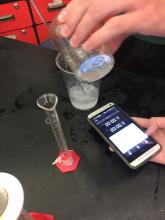
"What are we doing to help kids achieve?"
My students and I tend to have good experiences with a hydrate inquiry lab that I have "tweaked" (see the previous blog). Essentially, my students have some practice with hydrates in the lab and then they are provided an unknown hydrate. They must separate off the water by heating and calculate the mass of the anhydrous salt and container before they come up and put it on the scale. As an added twist, they must also ask me a question about what information they need from me to calculate the mole to mole ratio of the salt to water. It has worked well in the past but then in some of my other classes we hit third quarter.....
It was after winter break, before spring spring break and everyone was tired. There had been no snow days. Juniors were stressed over taking the ACT and other mandated tests. It was the last week of the quarter. The atmosphere was that it would be hard to get any major labs done. I really wanted to fit in this lab. Some of my classes had really struggled with moles and were nailing percent composition and the idea of hydrates. I really did not want to give this lab up but I felt like it was a bit much at the time. Here was my "Plan B".
First, I demonstrated how to apply the concept of percent composition to hydrates. We solved for the percent of water in copper (II) sulfate pentahydrate. We then used that information to predict the mass of an amount of the anhydrous salt of copper (II) sulfate. We did the calculation and demonstration as a class. Students were then given three homework problems that involved finding the percent of water in three different hydrates. The next day, the first part of the lab was a quick check to see if they did the homework and showed their work. Each student then came up and were assigned one of the three hydrates on their homework. The task was to heat the hydrate enough to drive off the water and predict the final mass on the scale. Students were to calculate the mass of the anhydrous salt and the container as it was cooling. They then had to show me their work before they found the final mass. I had to see their work first and I was the only one to have access to the scale. The closer they got to the correct predicted value on the scale, the higher their grade.
This "plan B" worked well and there were several features I liked about it as a teacher. It emphasized the importance of doing homework. If students did not do their homework and actually apply it, they would not predict the correct mass. Each student received a different salt or different amounts or both. This meant that they could help each other but it made direct copying difficult. Another nice feature is that because it is a microscale lab, every student had to participate and do their own experiment. Students also got immediate feedback. They knew as soon as they put the dried salt and container on the scale if they successfully did the calculations. In some cases, students knew right away that their predicted mass was incorrect. I let those students try it again for some credit. Most students did well. Overall, this lab activity was managable, easy to grade, provided immediate feedback and got the chemicals in the hands of as many students as possible.
Do you have a "plan B" that worked better than expected? Would love to hear from you....


































 Fig. 1 - Starting materials for demonstration
Fig. 1 - Starting materials for demonstration

